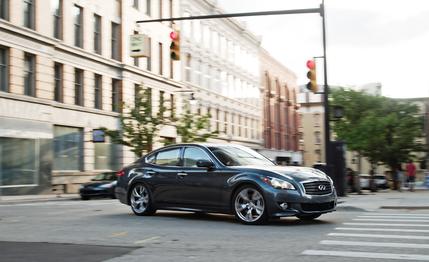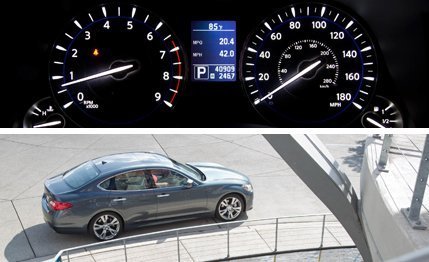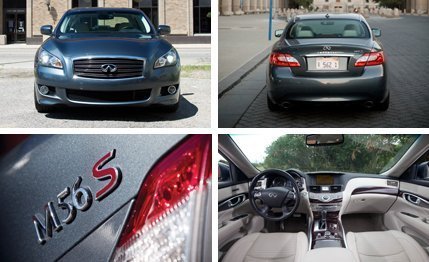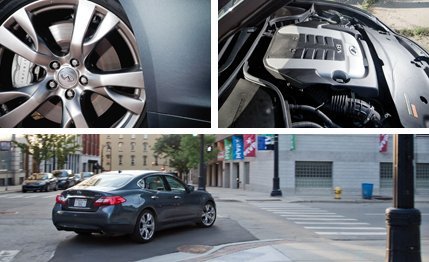
 Long-Term Road Test Wrap-Up
Long-Term Road Test Wrap-Up
One look at the stylish 2011 Infiniti M56 was enough to whet our appetites. Then the spec sheet—showing the car’s optional V-8 (a 95-hp boost versus its comparo-winning M45 predecessor)—whetted them more. And the performance results in our M56 road test [June 2010] pretty much sealed the deal. We needed to see how this aggressive update on Infiniti’s top-drawer sedan (now that the Q45 has vanished) would stand up to the not-so-tender mercies of Michigan roads for 40,000 miles.
Lots of muscle, head-turning sheetmetal, gorgeous interior, and lots of tech goodies: What could possibly go wrong? We anticipated a communion of unalloyed joy, 40,000 miles of pure driving pleasure. A long-legged thoroughbred created to make miles disappear at wholesale rates, simultaneously making its driver look forward to the next hundred—or thousand—miles with anticipation.
That summarizes our expectations as the M56S joined our long-term test fleet.
The reality was something else. Over the course of almost 16 months and 41,693 miles, the suite of advanced electronics (adaptive cruise, lane-departure warning and prevention, blind-spot warning and intervention, collision warning, brake assist, adaptive headlights, “eco” mode) bundled into the $3000 Technology package had more hiccups than a champagne aficionado on New Year’s Eve.


Everyone who tried the “eco” setting, which physically limits gas-pedal travel to save fuel, reported that one try was enough and never used it again. The adaptive cruise control went through cranky episodes when it refused to set—the only way to bring it back online was to stop, shut off the ignition, and start up again; basically, to reboot. It got old. The same can be said for a loss of traction-control function, which, consistent with Murphy’s Law, occurred midwinter.
Dashboard warning lights, with cryptic labels—“4WAS” and “IBA”—were frequent and defied interpretation without referring to the owner’s manual. On a couple of occasions, the dashboard lit up like a pinball machine, a digital rebellion that ultimately led to the replacement of the car’s ECU, which took almost a month. This measure diminished—but did not entirely eliminate—the dashboard light show.
Of the Tech-package elements that worked reliably, several proved to be a source of irritation. In addition to the “eco” mode, the lane-keeping features—lane-departure warning and active departure prevention—were a little too zealous, although at least these could be defeated. The collision-warning system had a similarly low panic threshold, and for once we found ourselves wishing we’d listened to our man Aaron Robinson, who had warned against ordering this package in our road test. He summed it up as “anti-fun software,” a characterization that proved to be more accurate than he imagined.
Robinson labeled the $3650 Sport package as a “maybe,” but that’s another box we wish we hadn’t checked. It includes 20-inch cast aluminum wheels (startlingly expensive at $1539 each; how do we know? Don’t ask), shod with 245/40 Bridgestone Potenza RE050A performance tires, high-performance brake pads, four-wheel active steering, sporty front trim, bucket seats with more lateral support, and, of course, stiffer suspension tuning.


It’s this last element—the firmer suspension—that we regret. The steering didn’t make everyone happy—quick (2.5 turns lock to lock) to the point of dartiness, not much tactile info—and we expected slightly better grip (0.87 in the final test). But the combination of stiff suspension and low-profile tires added up to ride quality that made just about everyone unhappy. The word “harsh” appeared regularly in the logbook.
The heavy wheels, unyielding suspension, and patchwork Michigan pavement also combined to put more impact energy into the body shell than it could manage, and as the miles mounted, this produced a small chorus of creaks and rattles that were not at all luxurious. And those weren’t the only unwelcome noises. The M56S had been in our care for only a few months when logbook reports began to include mention of low-grade mechanical sounds—one driver characterized it as “mooing.” Despite a number of complaints, our dealer’s service department was unable to find a problem, nor were the techies able to diminish the noises, which persisted throughout the rest of the test.
On a splendid late May day, at 3410 miles, the sunroof dutifully opened, then steadfastly refused to close, an irritation amplified in direct proportion to the length of time required to restore function: 27 days. That’s how long it took Infiniti to get a new sunroof motor to our dealer’s service department. All told, it was not exactly a triumphal track record.
Of course, there were some positive notes. Power, for example. The M56S is propelled—vigorously—by a 5.6-liter, DOHC 32-valve direct-injection V-8: 420 horsepower at 6000 rpm, 417 pound-feet of torque, mated to a seven-speed automatic offering a manual shift mode. Put the pedal to the floor, and the M56S responds with a riptide of torque, a gratifying asset for exploiting tight seams in freeway traffic, even though some found throttle tip-in to be touchy.


Our M56S achieved its best acceleration results in its first visit to the test track with 1347 miles on the clock: 0 to 60 in 4.7 seconds, the quarter in 13.2 at 108 mph. That’s unusual; most engines loosen up toward the end of a long-term tour. Then again, 4.9 seconds to 60 and a 13.5-second quarter-mile at 107 mph isn’t likely to produce a ho or a hum.
Braking, augmented by high-friction pads ($370), was strong from the first test (165 feet from 70 mph) to the last (161), though there were a couple of complaints about noise, and we had to replace the front pads at 35,713 miles.
Styling was another strong suit, inside and out, although not as widely seductive as the car’s power. But the nav system—a standard feature—won consistent praise, and the 16-speaker Bose premium audio system helped make some of the car’s glitches a little more tolerable. Then again, as part of a $2000 option package that included Infiniti’s Forest Air system, which varies dashboard-vent airflow to remind occupants of woodland breezes (sans bear odors), the performance of the audio system should rival the New York Philharmonic in Carnegie Hall.


Which brings us to costs. The various electronic problems we encountered were covered by warranty, and the tab for five routine service visits came to a not-unreasonable $729. But nonwarranty work ran substantially higher. The damaged wheel, a cracked windshield ($1121), various repairs ($920), and replacement tires (Bridgestone Potenza S-04 Pole Position XLs for $1435) added $5015 to operating expenses, and fuel added another $6780 (the EPA forecast 16 mpg city and 25 highway; we averaged 20).
We can’t blame the M56S for the costs of the wheel or the windshield. But it’s hard to avoid disappointment with the litany of problems and irritations encountered in a sedan at this price level.
Mr. Robinson was right. We should have voted “hell, no” on the Technology package. We should have voted no on the Sport package, too. And it’s a good bet that life with the standard 10-speaker Bose audio—as distinct from the super 16-speaker system that goes with the Sport Touring package—would have been tolerable. Even with the absence of Forest Air.
Delete all the extras, and you have a $58,415 M56, a car with the same power, more comfort, and fewer headaches.
Then again, one test driver wondered if we’d have been better off going with the M37 and its 330-hp, 3.7-liter V-6—$47,925 base, $50,075 with four-wheel drive (2011 prices). At the end of the road with this M56S, we can’t help thinking that would have been the better choice.